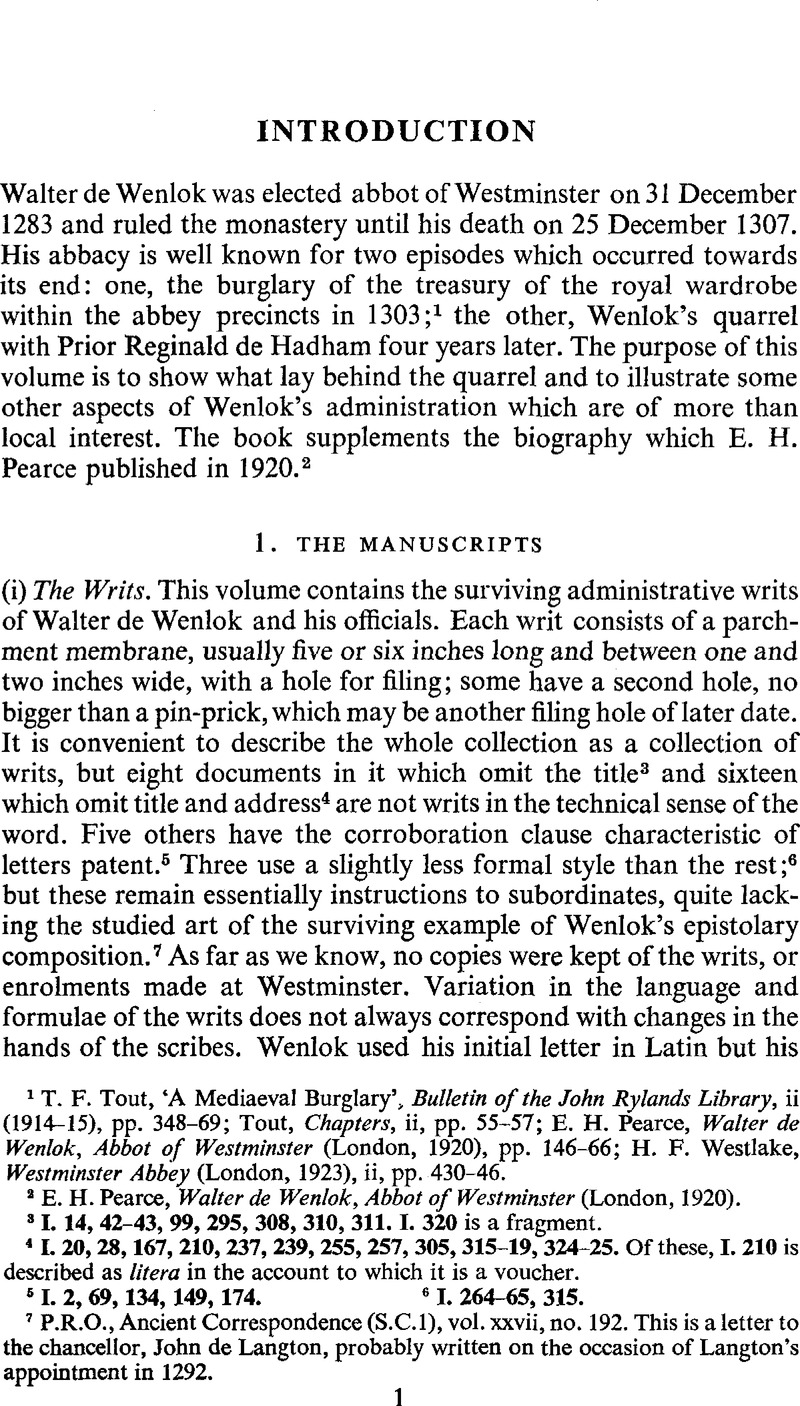No CrossRef data available.
Article contents
1. The Manuscripts
Published online by Cambridge University Press: 21 December 2009
Abstract

- Type
- Introduction
- Information
- Copyright
- Copyright © Royal Historical Society 1965
References
page 1 note 1 Tout, T. F., ‘A Mediaeval Burglary’, Bulletin of the John Rylands Library, ii (1914–1915), pp. 348–69Google Scholar; Tout, , Chapters, ii, pp. 55–57Google Scholar; Pearce, E. H., Walter de Wenlok, Abbot of Westminster (London, 1920), pp. 146–66Google Scholar; Westlake, H. F., Westminster Abbey (London, 1923), ii, pp. 430–46.Google Scholar
page 1 note 2 Pearce, E. H., Walter de Wenlok, Abbot of Westminster (London, 1920).Google Scholar
page 1 note 3 I. 14, 42–43, 99, 295, 308, 310, 311. I. 320 is a fragment.
page 1 note 4 I. 20, 28, 167, 210, 237, 239, 255, 257, 305, 315–19, 324–25. Of these, I. 210 is described as litera in the account to which it is a voucher.
page 1 note 5 I. 2, 69, 134, 149, 174.
page 1 note 6 I. 264–65, 315.
page 1 note 7 P.R.O., Ancient Correspondence (S.C.1), vol. xxvii, no. 192. This is a letter to the chancellor, John de Langton, probably written on the occasion of Langton's appointment in 1292.
page 2 note 1 E.g. I. 208, 218.Google Scholar
page 2 note 2 The phrase sigillum … secretum occurs in I. 174.Google Scholar
page 2 note 3 I. 6, 9 (with slits), 8, 11, 17, 19, 48–49, 210–11, 247, 255, 266.I. 341, sent by a steward of the household, may also have slits for a thong.
page 2 note 4 I. 210–11, 247.
page 2 note 5 Below, pp. 7, 26.
page 2 note 6 I. 326–49. It has been assumed that I. 346–48, which use the singular person, were not sent by the abbot himself.
page 3 note 1 The exceptions are I. 342 and 349. Three of the abbot's writs (I. 154, 302, 308) slip into the singular person.
page 3 note 2 One of the abbot's writs (I. 235) has script' instead of dat'.
page 4 note 1 Davis, G. R. C., Medieval Cartularies of Great Britain (London, 1958), p. 116.Google Scholar
page 4 note 2 Below, p. 241.
page 4 note 3 Below, p. 14.
page 4 note 4 Below, p. 242 and note.
page 4 note 5 Below, p. 247.
page 5 note 1 Below, p. 247.
page 5 note 2 Ibid., notes. The monk-warden of ‘La Neyte’ acted as bailiff of ‘Eye’; the reeve of ‘Eye’ was therefore the principal lay official on the manor.
page 5 note 3 V. C. H. Oxon., vi (London, 1959), p. 209Google Scholar; W.A.M. 32691; Westminster Domesday, fos 318v–319.
page 5 note 4 Below, pp. 242, 246.
page 5 note 5 Below, p. 248 and note.
page 5 note 6 The Customary of St Augustine's Canterbury, which was related to Ware's Customary, survives in a fourteenth-century manuscript also containing the regulations of Nicholas de Spina, a late-thirteenth-century abbot of St Augustine's, for his household and a list of his familia (Customary, ii, pp. vi–ixGoogle Scholar; i, pp. 51–64). But the list and regulations are a compilation separate from the Customary and cannot be used as an argument that Ware's Customary originally contained similar material (ibid., i, pp. vi–viii).
page 5 note 7 Walter de Wenlok, p. 112Google Scholar; see Tout, , Chapters, ii, pp. 158–63.Google Scholar
page 6 note 1 Below, p. 248.
page 6 note 2 W.A.M. 19168–223; see especially W.A.M. 19177, 19199.




